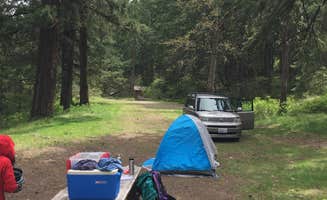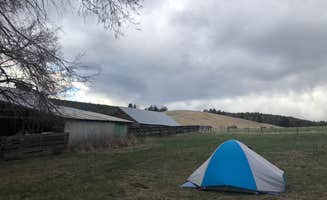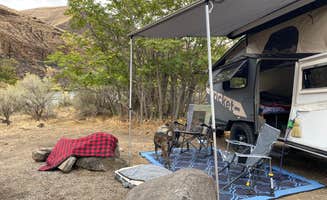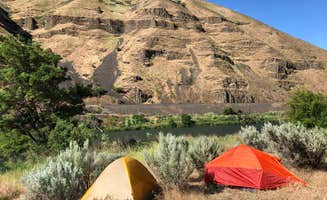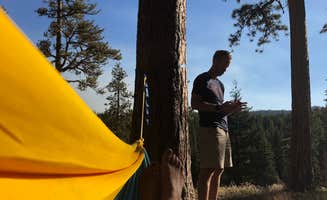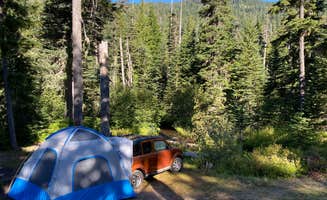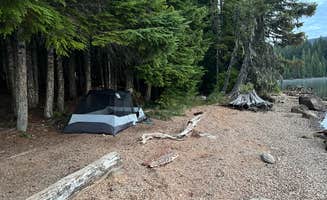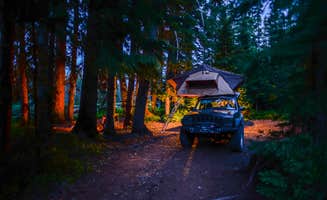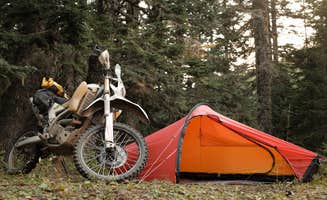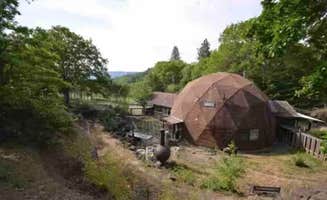Tent camping near Maupin, Oregon centers on the transition zone where forested mountains meet high desert terrain. The area sits at elevations between 850 to 2,100 feet, experiencing temperature swings of 30-40 degrees between day and night during summer months. Seasonal restrictions apply to most camping areas, with the majority of tent sites closing between late October and early May due to weather conditions and resource protection.
What to do
Hiking access from camp: Several campgrounds connect directly to trail systems. At Bonney Crossing, you can access the Badger Creek Trail about 100 feet from your campsite. According to Bjorn S., it's "a versatile, climate-variety hike that sports a good stopping point at Pine Creek about 6 miles in, then to Badger Lake another 6 miles beyond that."
Railroad line exploration: From Macks Canyon Recreation Site, access a unique hiking experience along an old railway line. Sarah S. notes, "From the end of the Lower Deschutes Access Road just above the campground, you can hike along the old railway line. Again, amazing views of the Deschutes and the canyon. We did about 5 miles road trip but you could go further."
Mountain biking trails: The eastern Mt. Hood wilderness near Pebble Ford Campground offers excellent mountain biking terrain. Bjorn S. recommends, "Near some nice trails and gorgeous mountain views... Bring your mountain bike." The area provides both technical sections and easier routes suitable for intermediate riders.
What campers like
Privacy between sites: Despite having just seven established sites, Bonney Crossing provides substantial space between campsites. Scott B. describes it as "a quiet relaxing two nights of camping" where "kids loved spending time exploring the creek and cooling off in it."
Night sky viewing: The Maupin area's low light pollution makes for exceptional stargazing. According to Greg L., Bonney Crossing offers "off-season perfection" where "we were there for 2 nights and didn't see any other people." Similarly, tent campers appreciate the isolation at Badger Lake Campground where Michael P. notes, "I preferred camping away from the lake since I had the whole place to myself."
Established fire rings: Most campsites feature permanent fire rings, important for safely containing fires in this fire-prone region. Greg L. mentions that at Bonney Crossing, "All the campsites had fire rings and there was plenty of scrap wood to be found." Remember that seasonal fire restrictions often apply during summer months.
What you should know
Vehicle requirements: Many camping areas require high-clearance or 4WD vehicles. At Keeps Mill Campground, Tristan T. warns, "You MUST have a high-clearance 4x4. The worst stretch of road is narrow with steep wall on one side and steep drop on the other. You will not be able to turn around."
Wind conditions: Canyon areas around Maupin regularly experience strong, sudden winds. At Macks Canyon, James W. notes, "We went during weather transition from rain to clear. The result, high winds in the canyon. This only lasted the one night." Sarah S. adds, "The only negative is that it can get super windy. At one point we were frantically trying to get our awning down from the Cricket and things were flying everywhere."
Water availability: Most tent sites near Maupin lack potable water. Scott B. describes Bonney Crossing as "primitive" so "you must bring your own potable water." This applies to nearly all camping areas, even established campgrounds with other amenities.
Tips for camping with families
Creek exploration: Children particularly enjoy the accessible water features. At Barlow Crossing, Kelly K. mentions, "We have a favorite dispersed campsite that is right on the creek. Quiet and serene. We always have deer come visit us." These creekside locations provide natural entertainment and cooling options during hot days.
Wildlife viewing opportunities: Multiple campsites offer chances to see wildlife up close. Nik P. from Pebble Ford Campground shares, "Had some deer walk right through our camp spot while we sat by the fire." Morning and evening hours typically provide the best wildlife viewing opportunities.
Bathroom facilities: Facility quality varies significantly between campgrounds. Parents appreciate locations with maintained facilities like Pebble Ford, which Stephanie Z. describes as having "a toilet/outhouse, but no running water." When camping with children, prioritize sites with established toilet facilities to avoid teaching leave-no-trace bathroom skills.
Tips from RVers
Site spacing considerations: RVers appreciate the generous sizing at certain campgrounds. At Pebble Ford Campground, Bjorn S. exclaims, "Small… we're talkin' 3-4 sites… but each site is HUGE! Refreshing to see, and how cool to get here and take over all three with a party."
Road condition updates: Access roads deteriorate throughout the season. James W. notes about Macks Canyon, "I go off-road a lot. I have never experienced a washboard road as bad as this was for 6-7 miles. I thought the doors were going to blow off the truck. Not an exaggeration."
Campsite selection strategy: Arrive on weekdays for better site selection. Dawn O. shares her experience at Barlow Crossing: "We went on a Monday in early August, to this lovely 4 site campground. We were able to camp at (in my opinion) the best site, which was right on Barlow Creek. We had the campground all to ourselves for the first 3 nights."


